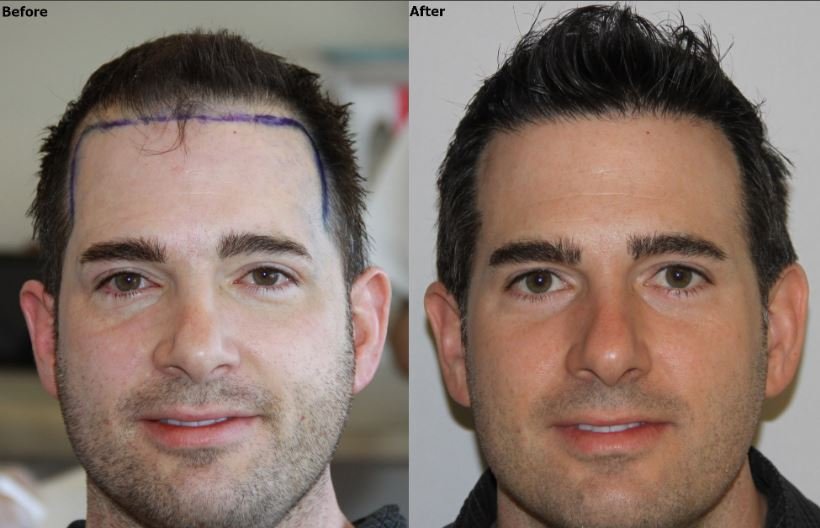Those with a high Highline tend to look like they have a prominent forehead, making them uncomfortable. But a hairline lowering transplant is a procedure that helps to rectify this issue. It usually presents unproportional facial features. Another reason a person may find it necessary to have this treatment is to fix a receding hairline. Other than that, this procedure has many other benefits that we shall look at in detail.
What is Hairline Lowering Transplant?
Hairline advancement treatment is ideal for people with overly high Highline or receding hairlines. It’s a process that restructures a person’s hairline by moving them down their foreheads. A surgeon can use advanced techniques such as follicular unit transplant or follicular unit extraction. These procedures help to structure your facial balance. And the most viable treatment is a hair transplant.
So, a surgeon can use FUT or FUE techniques for a hairline lowering procedure. Both involve removing some hair from a scalp area with healthy strands and implanting them on the receding hairline. If a person wants to reduce a prominent forehead, a surgeon will draw and mark the appropriate area where the hair will start. Then makes microscopic incisions where the grafts will go for implants. The FUT procedure may be the best for this process. A surgeon must always consider a person’s facial features and how the hair flows naturally. But most importantly, how the clients want the shape of their hairline.
Hairline Lowering Surgery Procedure
A surgeon can perform a hairline lowering surgery in one or multi-stage. It depends on the lowering work required and the present scalp laxity. A surgeon can use one procedure to carefully make and camouflage incisions along the hairline. Then the hair-bearing scalp shortens the forehead with a single surgical procedure. Another procedure is a hairline lowering transplant that helps to cover scars or customize the hairline shape. Some patients may require a second treatment session after the scalp has stretched further. However, it’s a rare situation and can only lower the hairline one additional cm, not more than that. Brow lifting is a standard surgical procedure that most surgeons incorporate with hairline lowering in only one stage. And it can provide significant results of improved and shorter appearance of the forehead.
Ideal Candidate?
An eligible patient for a hairline lowering transplant is one who:
- experiences a receding hairline
- has a natural higher hairline
- has a flexible scalp and a stable front hairline.
- Can withstand a surgical procedure.
Transgender people undergoing a male-to-female transition and are medically stable on hormone therapy can also make excellent candidates for this surgery. It helps to correct and shape a hairline, giving them their desired facial features. You might not be an ideal candidate for this procedure if you have thin hair or a very high hairlines. If your hair lacks density, it will not camouflage the scar. And when your hairline is very high, you may need tissue expansion to get a successful forehead reduction procedure. Also, you may not be eligible for this treatment if you have medical conditions such as wound healing disorders, heart disease, active scalp disease, bleeding disorders, scarring, and other serious medical problems.
Benefits of Hairline Lowering Transplant
Hair transplant-lowering benefits are almost obvious; as the name suggests, it reduces a high hairline.
- It’s a procedure that helps to reduce a protruding forehead.
- The hairline lowering process uses an advanced technique that is safe and effective.
- It gives a permanent solution
- It helps to restructure a hairline.
- It enhances a person’s facial structure and overall appearance.
- The procedure produces a natural-looking appearance.
- It requires a few hours, and so it’s an outpatient procedure
- The treatment works on most types of scalp.
How Safe is Hairline Lowering Surgery?
Since the procedure involves advanced hair restoration techniques like FUT and FUE, these are safe and effective. However, the success and safety of this procedure highly depend on the practitioner. Generally, this is a risk-free procedure, and the local anesthesia offered before the treatment helps to reduce pain and distress.
Possible Side Effects
You can always expect some adverse reactions to any surgical procedure. Some of the risks or side effects you may experience include:
- Scalp numbness
- Bruising
- Swelling
- Bleeding
- Scarring (FUT technique)
Poor wound healing and infection are rare effects that some people might experience. First, you might experience newly transplanted hair falling, which is expected (shock loss) but doesn’t last long.
In Conclusion
A hair transplant hairline lowering procedure requires a surgeon who understands the patient’s needs before getting into it. First, a patient must schedule a doctor’s appointment for evaluation and suggestion of the ideal treatment. Upon this, you can achieve a well-structured facial appearance that’s safe and natural-looking. So, if a protruding forehead makes you uncomfortable, you know what to do.








Leave a Reply